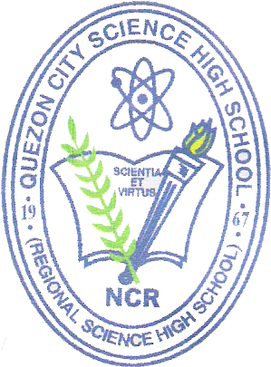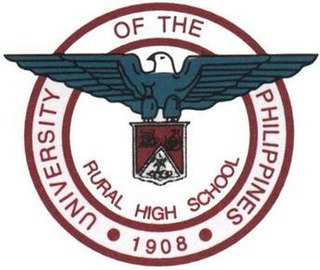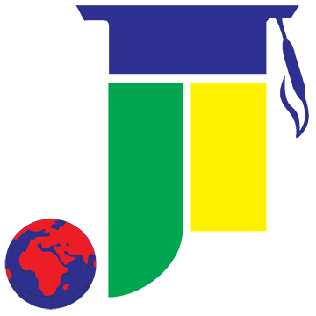
The University of the Philippines is a state university system in the Philippines. It is the country's national university, as mandated by Republic Act No. 9500, giving it institutional autonomy.

The University of the Philippines Diliman, also referred to as UP Diliman or simply University of the Philippines (UP), is a public, coeducational, research university located in Diliman, Quezon City, Philippines. It was established on February 12, 1949, as the flagship campus and seat of administration of the University of the Philippines System, the premier and national university of the Philippines.

Quezon City Science High School is the Regional Science High School for the National Capital Region. It is the premier science high school of Quezon City, and is regarded as one of the prestigious sciences triumvirate of the Republic of the Philippines along with the Philippine Science High School and Manila Science High School. It is located at Golden Acres Road, Corner Misamis Street, Bago-Bantay, Quezon City, Philippines. Founded in September 17, 1967, it was appointed as the Regional Science High School for the National Capital Region since 1998.

The University of the Philippines Rural High School was established as a subsidiary of the Department of Agricultural Education of the University of the Philippines College of Agriculture, pursuant to Sec.4 of Act 3377 of the Philippine Legislature which was approved on December 3, 1927. The school, with a vocational curriculum, served as a practice school for the training of teachers, provided secondary education in agriculture for those preparing for college, and trained intermediate school graduates in agriculture.

The Philippine Science High School System is a research-oriented and specialized public high school system in the Philippines that operates as an attached agency of the Philippine Department of Science and Technology. PSHS is considered as the top science high school in the Philippines and is viewed to be among the best in the ASEAN region by 2016.

The Philippine Science High School - Main Campus is the flagship campus of the Philippine Science High School System. It was founded in 1964. It is located along Senator Miriam P. Defensor-Santiago Avenue, Diliman, Quezon City.
Philippine Science High School Southern Mindanao Campus is the first regional campus of the Philippine Science High School System, a specialized public high school in Davao City, Philippines. It caters to scientifically and mathematically gifted high school students from the Southern Mindanao region of the country. It is located in Barangay Sto. Niño, Tugbok District, Davao City.
The Philippine Science High School Western Visayas Campus (PSHS-WVC), one of the campuses of the Philippine Science High School System, is located at Brgy. Bito-on, Jaro, Iloilo City, Philippines. Established in 1993, the school admits and grants scholarships to students who are gifted in the sciences and mathematics. Most of the scholars are from Western Visayas which covers the provinces of Aklan, Antique, Capiz, Guimaras, Iloilo and Negros Occidental, as well as the Mimaropa, which includes the provinces of Occidental Mindoro, Oriental Mindoro, Marinduque, Romblon and Palawan. Until the establishment of PSHS Central Visayas in 2009, the campus also catered to the students from the Central Visayas provinces of Bohol, Cebu, Negros Oriental and Siquijor.
The University of the Philippines College Admission Test, commonly known as UPCAT, is part of the admission requirements of the University of the Philippines, administered to graduates of Philippine and foreign high schools. The test was first administered in 1968.

Quezon National High School (QNHS) is a major public secondary science high school in Brgy. Ibabang Iyam, Lucena City, Philippines. It is one of the largest contingent national high schools in the Philippines, both by size and by population, with more than 11,000 enrollees from Grades 7 to Grade 12.
The Science, Technology, Engineering and Mathematics Education Program is a science and mathematics-oriented curriculum devised for high schools in the Philippines. The STEM program is offered by specialized high schools, whether public or private, supervised by the Department of Education. Currently, there are 110 high schools offering the STEM program, the majority being public. It was piloted in 1994 by the Department of Science & Technology (DOST).

The University of the Philippines College of Law is the law school of the University of the Philippines Diliman. Formally established in 1911 in UP Manila, it is the third oldest continually-operating law school in the Philippines. Since 1948, it has been based in UP Diliman in Quezon City, the flagship of the UP System's eight constituent universities. The college also holds extension classes at the Bonifacio Global City campus of UP Diliman in Taguig and the Iloilo City campus of UP Visayas.

Philippine Science High School – Cagayan Valley Campus (PSHS–CVC) is a campus of the Philippine Science High School System, a specialized public high school that admits and provides scholarships to high school students primarily from the Cagayan Valley region. It is located in Barangay Masoc, Bayombong, Nueva Vizcaya. Prior to its inclusion into the PSHSS, the school was named the Nueva Vizcaya Science High School, and was located at the Nueva Vizcaya State University compound. It first opened in 1996, 4 years after the law that created the school had passed in Congress.

Philippine Science High School Central Mindanao Campus (PSHS-CMC) is the second Mindanao campus of the Philippine Science High School System, a specialized public high school in the Philippines. It caters to scientifically and mathematically gifted high school students from all over the country especially those in Mindanao. It is located in Nangka, Baloi, Lanao del Norte.
Philippine Science High School - Ilocos Region Campus (PSHS-IRC) is a campus of the Philippine Science High School System, a specialized public high school in the Philippines, and under the Department of Science and Technology (DOST). PSHS-IRC was established in 2003 through the initiative of former Ilocos Sur 1st district Cong. Salacnib Baterina.

The Valenzuela City School of Mathematics and Science, also referred to as VCSMS and ValMaSci, is a specialized public high school in Valenzuela City, Philippines.

The Philippine Science High School - Central Luzon Campus is the 11th campus of the Philippine Science High School System which admits and grants scholarships to students who are gifted in science and mathematics. Admission to this campus is by passing the National Competitive Examination organized and conducted by the PSHS System annually and only Filipino citizens are qualified to attend. Most of the scholars are from Central Luzon which covers the provinces of Aurora, Bataan, Bulacan, Nueva Ecija, Pampanga, Tarlac, and Zambales. Some of the scholars came from neighboring provinces like Manila, Batangas, Rizal, Laguna, Pangasinan, and Palawan. Philippine Science High School - Central Luzon Campus excels both at academics and at co - curricular activities.
The Philippine Science High School - Calabarzon Region Campus (PSHS-CALABARZONRC) is the 14th campus of the Philippine Science High School System located at Brgy. Sampaga, Batangas City. The campus specializes in Integrated Sciences, Mathematics, and Computer Sciences while still pertaining to the standard humanitarian subjects such as Physical Education and Music. The school's expansive and intensive nature of studies along with skilled and handpicked teachers has garnered it a reputation of producing some of the best students in the field of Science and Mathematics in both the region and the Philippines. The campus, having only started its groundbreaking ceremony on March 10, 2016, is still under construction with multiple unfinished facilities.

The Philippine Science High School - Caraga Region Campus (PSHS-CRC) is the 13th campus of the Philippine Science High School System located at Brgy. Ampayon, Butuan. The school admits and grants scholarships to students who are gifted in science and mathematics. It caters to scholars from Caraga which covers the provinces of Surigao del Norte, Surigao del Sur, Dinagat Islands, Agusan del Norte, and Agusan del Sur. Some scholars come from nearby provinces of Region X. A few from other regions of the country. The PSHS-CRC formally opened in June 2014.

Joji Ilagan Career Center Foundation, Inc. is a conglomerate of schools under the JIB Group of Companies, based in Davao City, Philippines. It was founded by its chairwoman, Joji Ilagan Bian, after whom the school is named.













